The Snowglobe Nebula is a bipolar planetary nebula located approximately 1,500 light-years away in the constellation Aquila (the Eagle). It has an apparent magnitude of 11.4 and an apparent size of 1.9 by 1.8 arcminutes. It is listed as NGC 6781 in the New General Catalogue.
NGC 6781 was nicknamed the Snowglobe Nebula because its interior is partly transparent and the light of stars that appear in the same field of view make the nebular ring appear like a snow globe with suspended snowflakes.
Even though it appears as an almost perfect bubble of gas from our point of view, the Snowglobe Nebula has a bipolar dust shell that is in fact barrel shaped. We see the nebula as it appears almost pole-on. The appearance of the perfect ring is an optical illusion. If we were to see NGC 6781 from the side, the cosmic bubble would appear as an hourglass, similar to the better-known Dumbbell Nebula (Messier 27) in the constellation Vulpecula (the Fox).
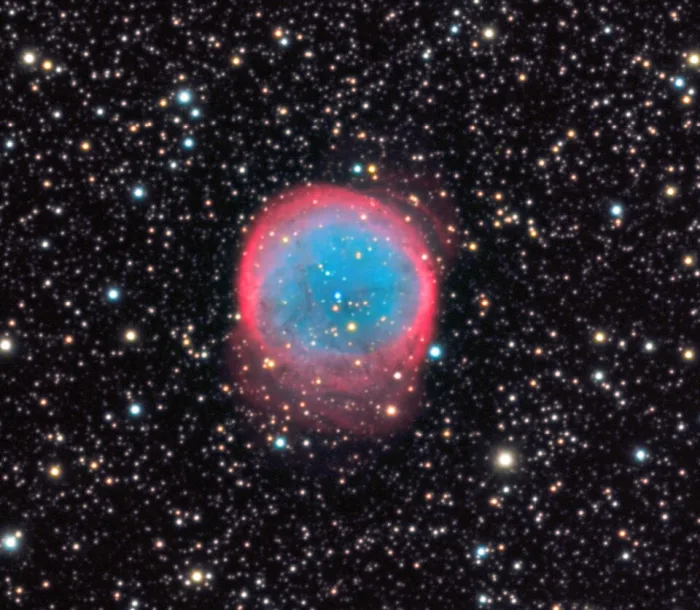
Snowglobe Nebula (NGC 6781), image credit: Adam Block/Mount Lemmon SkyCenter/University of Arizona (CC BY-SA 4.0)
The nebula’s true shape was identified in a 2011 study based on observations with the Nordic Optical Telescope, Hubble Space Telescope, the infrared Spitzer Space Telescope and the Infrared Space Observatory. The team of researchers found that the nebula has unusual kinematic characteristics and emission lines and proposed that it was a bipolar nebula oriented close to the line of sight.
The Snowglobe Nebula is comparable in size to the brighter Ring Nebula (Messier 57) in the constellation Lyra. It has a mean radius of 0.489 light-years, or around 31,000 astronomical units (Earth – Sun distances). It has an expansion velocity of 12 km/h, a kinematic age of 8,100 years and an evolutionary age of 5,190 years.
The unique planetary nebula formed when the central evolved star reached the late stages of its evolutionary cycle and expelled its outer layers into space. The expanding clouds of ejected material are heated by the intense ultraviolet light from the central stellar remnant.
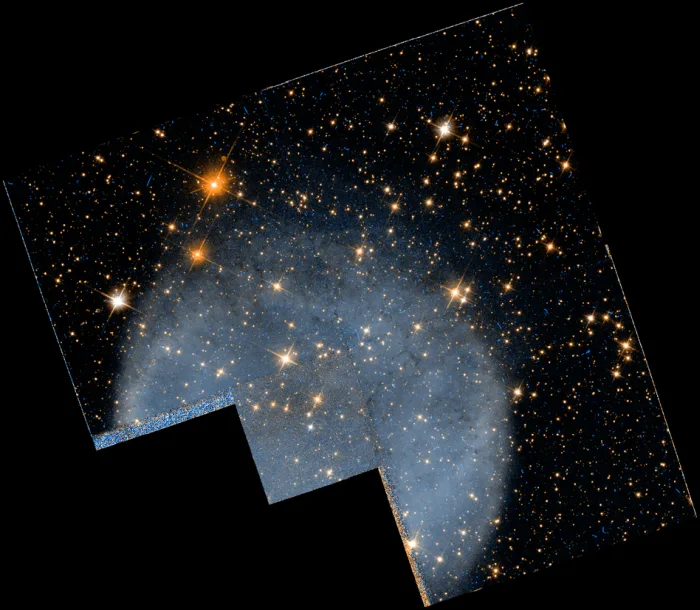
Snowglobe Nebula, based on observations made with the NASA/ESA Hubble Space Telescope, and obtained from the Hubble Legacy Archive, which is a collaboration between the Space Telescope Science Institute (STScI/NASA), the Space Telescope European Coordinating Facility (ST-ECF/ESA) and the Canadian Astronomy Data Centre (CADC/NRC/CSA) (CC BY-SA 3.0)
The bubble of material will continue to expand until it is too far from the central star to be ionized by the star’s ultraviolet radiation. At this point, it will fade from view. Planetary nebulae are a relatively short-lived phenomenon. They last only about 10,000 years.
Objects like the Snowglobe Nebula provide a preview of what our Sun will experience in 5 – 6 billion years. While massive stars like Rigel, Betelgeuse and Antares end their lives as luminous supernovae after a relatively brief stint as supergiants, Sun-like stars eject their outer envelopes of gas to form planetary nebulae and gradually cool to become dim white dwarfs surrounded by expanding nebulae that eventually dissipate into the interstellar medium.
The central star of the Snowglobe Nebula has an apparent magnitude of 16.88. It is a white dwarf of the spectral type DAO. The spectral class indicates that the stellar core remnant is a hydrogen- and helium-rich white dwarf that shows lines of ionized helium. The remnant has an estimated mass of 0.60 solar masses. Since evolving into a red giant, it has lost most of its initial mass of around 2.5 solar masses.
The central star of the Snowglobe Nebula is believed to have left the asymptotic giant branch (AGB) stage and started to cool around 9,400 years ago. As it experienced its last thermal pulse, it expelled 0.41 solar masses of gas. The estimated mass of the dust in the nebula is around 1.53 solar masses.
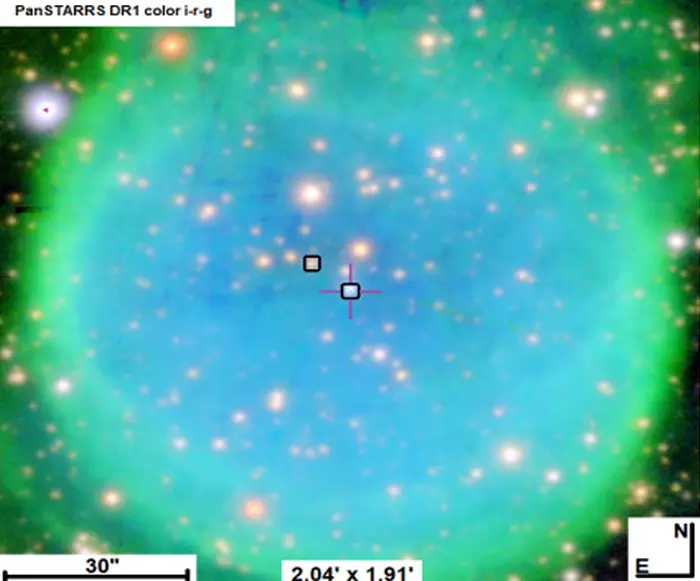
The central star system of the Snowglobe Nebula, image: Aladin Sky Atlas (CC0 1.0)
Facts
The Snowglobe Nebula was discovered by the German-British astronomer William Herschel on July 30, 1788. Danish astronomer John Louis Emil Dreyer, who compiled the New General Catalogue in 1888, described the object as “a planetary nebula, faint, large, round, very suddenly brighter middle and disc, small star to northeast.”
The progenitor star of NGC 6781 is part of a wide binary system. It has a proper motion companion, a red dwarf with an effective temperature of 3,400 kelvin, at a separation of less than 5,000 AU. The companion has an estimated mass of 0.35 solar masses. The properties of both stars were derived in a 2021 study based on the data from the Gaia Early Data Release 3 (Gaia EDR3).
The Snowglobe Nebula appears similar to the brighter and better-known Owl Nebula (Messier 97) in the constellation Ursa Major (the Great Bear). In larger telescopes, the central region of the nebula appears darker than the edges.

NGC 6781 photographed by the ESO 3.6-m Telescope, using the Faint Object Spectrograph and Camera (EFOSC2), at the La Silla Observatory in the Atacama Desert, Chile. Credit: ESO (CC BY 4.0)
Location
The Snowglobe Nebula lies in the central region of Aquila, on the wing axis of the celestial Eagle, about a third of the way from the white subgiant Delta Aquilae to Okab (Zeta Aquilae). Delta Aquilae marks the Eagle’s chest and is the brightest point of light between Altair (Alpha Aquilae) and Lambda Aquilae. The nebula appears 3.8 degrees north-northwest of Delta Aquilae and 2.5 degrees east-northeast of the evolved F-type star 19 Aquilae (mag. 5.227).
At declination +06° 32’, the Snowglobe Nebula is close enough to the celestial equator to be visible from virtually anywhere for at least part of the year. It can be observed in medium-sized telescopes at high magnification, and it requires good viewing conditions to be seen. The nebula’s central star is very faint and can only be spotted in larger instruments.
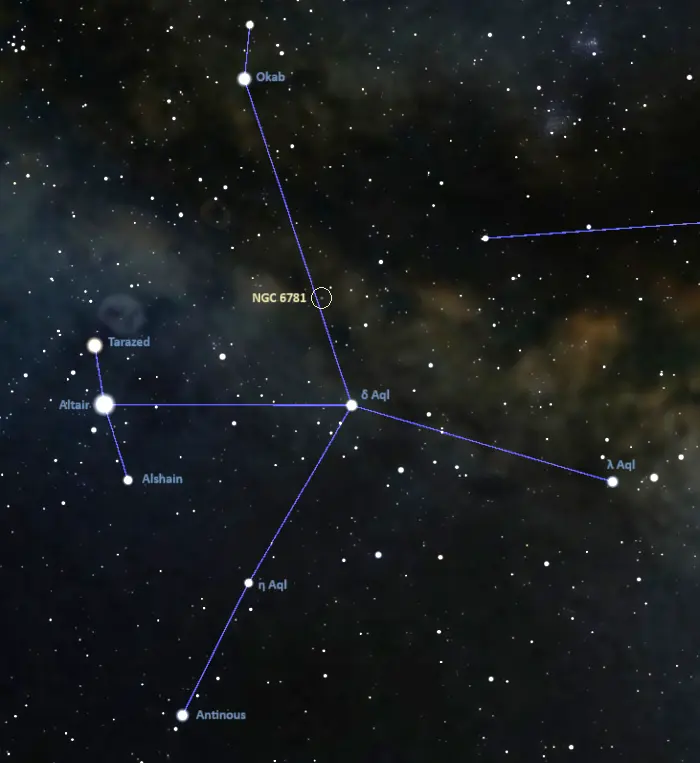
The location of the Snowglobe Nebula (NGC 6781), image: Stellarium
The best time of the year to observe NGC 6781 and other deep sky objects in Aquila is during the month of August, when the constellation appears high above the horizon around 9 pm. The celestial Eagle is prominent in the evening sky throughout the northern summer months.
Snowglobe Nebula – NGC 6781
| Constellation | Aquila |
| Object type | Planetary nebula |
| Right ascension | 19h 18m 28.085s |
| Declination | +06° 32′ 19.29″ |
| Apparent magnitude | 11.4 |
| Angular size | 1’.9 x 1’.8 |
| Distance | 1,500 light-years (460 parsecs) |
| Radius | 0.489 light years (0.15 pc) |
| Names and designations | Snowglobe Nebula, Snow Globe Nebula, NGC 6781, PN G041.8-02.9, PN VV 228, PN VV’ 492, PN ARO 32, PK 041-02 1, IRAS 19160+0626, GSC2 N023231154981 |
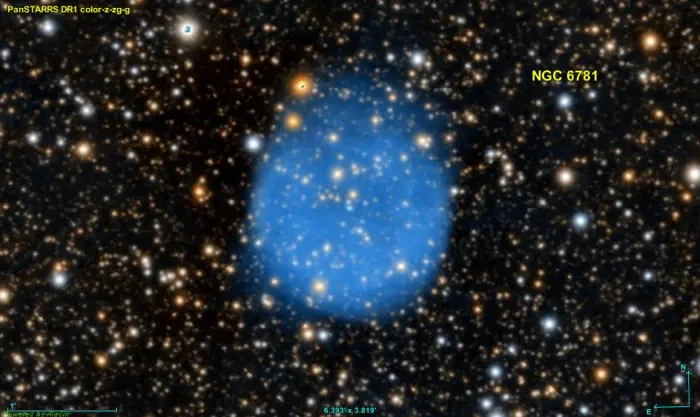
Snowglobe Nebula, image created using the Aladin Sky Atlas software from the Strasbourg Astronomical Data Center and Pan-STARRS ([https://panstarrs.stsci.edu/ Panoramic Survey Telescope And Rapid Response System) public data, credit: Donald Pelletier (CC BY-SA 4.0)